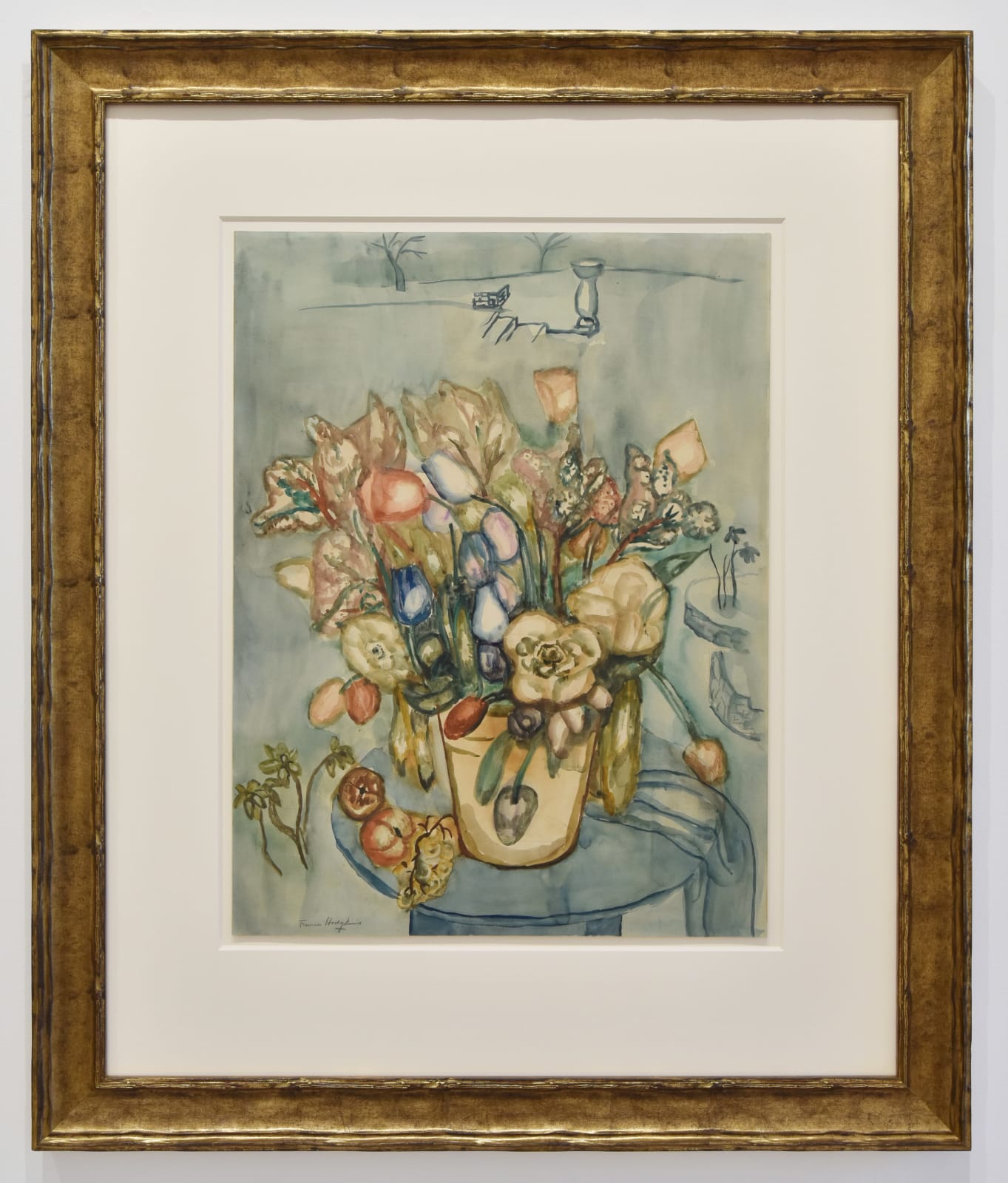



Frances Hodgkins
Flowers in a Bowl, c.1930
watercolour on paper
635 x 485mm
1025 x 845 x 30mm framed
1025 x 845 x 30mm framed
Further images
Text by Mary Kisler There is a lyrical quality to Flowers in a Bowl, indicative of the ground changing approach to landscape and still life that marked out Frances Hodgkins’...
Text by Mary Kisler
There is a lyrical quality to Flowers in a Bowl, indicative of the ground changing approach to landscape and still life that marked out Frances Hodgkins’ paintings in 1930. The harmonious, mainly warm tones of the individual flowers (which look to be in an earthenware plant pot, rather than a bowl), have delicate washes indicating petals, while bolder lines outline each bloom in turn. The container sits on a table outdoors, a folded cloth hanging over the edge on the right, leading the eye down to the right foreground, while on the left, a small clump of flowers may or may not be growing directly in the ground. An overall translucent blue wash demarcates the background, from which emerge two dislocated curving forms suggesting low brick walls. In the background, the same blue lines suggest part of a terrace and an urn, which may well be a landing stage leading down to the river Stour. A single bare tree trunk to the left is similar to the cork trees she painted in the south of France.
Arthur Howell’s exhibition of Hodgkins’ work at St George’s Gallery in October 1930 was to make her name in England. Writing later of Hodgkins’ evolving style, he noted that artists who introduced certain forms of abstraction into their work desired the viewer to value what he termed ‘judgments of relation’, to focus on floating motifs in their own right, rather than simply seeing them as part of a more complex whole. These floating forms are also reminiscent of historical Japanese prints, where it is left to the viewer to fill in depth of field, rather than using gradated tones and perspective to lead the eye from one object to another in a landscape.
Hodgkins persuaded Arthur Howell to send several paintings to Lucy Wertheim for the latter’s opening exhibition at the Wertheim Gallery, also held in October 1930. Flowers in a Bowl wasn’t part of the final selection, as Wertheim gifted it to Dorothy Elmhirst, a wealthy American socialite who became famous in England as a radical educationalist. She and her English husband Leonard Elmhirst set up the progressive Dartington School in 1925 in South Devon, an institution that eschewed traditional academic subjects in favour of the arts and agronomy. At the school’s core, Dartington Hall is a ravishingly beautiful medieval structure, which in the 20th century ultimately boasted a renowned collection of British modernist art.
There is a lyrical quality to Flowers in a Bowl, indicative of the ground changing approach to landscape and still life that marked out Frances Hodgkins’ paintings in 1930. The harmonious, mainly warm tones of the individual flowers (which look to be in an earthenware plant pot, rather than a bowl), have delicate washes indicating petals, while bolder lines outline each bloom in turn. The container sits on a table outdoors, a folded cloth hanging over the edge on the right, leading the eye down to the right foreground, while on the left, a small clump of flowers may or may not be growing directly in the ground. An overall translucent blue wash demarcates the background, from which emerge two dislocated curving forms suggesting low brick walls. In the background, the same blue lines suggest part of a terrace and an urn, which may well be a landing stage leading down to the river Stour. A single bare tree trunk to the left is similar to the cork trees she painted in the south of France.
Arthur Howell’s exhibition of Hodgkins’ work at St George’s Gallery in October 1930 was to make her name in England. Writing later of Hodgkins’ evolving style, he noted that artists who introduced certain forms of abstraction into their work desired the viewer to value what he termed ‘judgments of relation’, to focus on floating motifs in their own right, rather than simply seeing them as part of a more complex whole. These floating forms are also reminiscent of historical Japanese prints, where it is left to the viewer to fill in depth of field, rather than using gradated tones and perspective to lead the eye from one object to another in a landscape.
Hodgkins persuaded Arthur Howell to send several paintings to Lucy Wertheim for the latter’s opening exhibition at the Wertheim Gallery, also held in October 1930. Flowers in a Bowl wasn’t part of the final selection, as Wertheim gifted it to Dorothy Elmhirst, a wealthy American socialite who became famous in England as a radical educationalist. She and her English husband Leonard Elmhirst set up the progressive Dartington School in 1925 in South Devon, an institution that eschewed traditional academic subjects in favour of the arts and agronomy. At the school’s core, Dartington Hall is a ravishingly beautiful medieval structure, which in the 20th century ultimately boasted a renowned collection of British modernist art.
Provenance
Lucy Wertheim, EnglandGifted by Lucy Wertheim to Dorothy Elmhirst, England, 1930
Dartington Hall Trust, Totnes, Devon, England. Bequeathed by Mrs Dorothy Elmhirst
13
of
13



